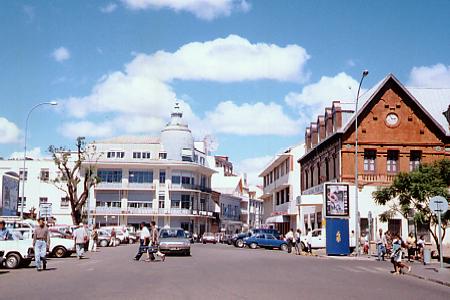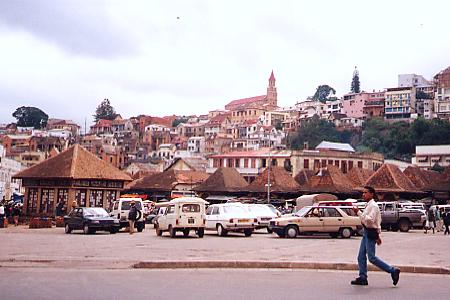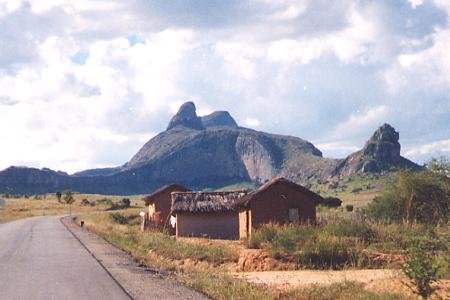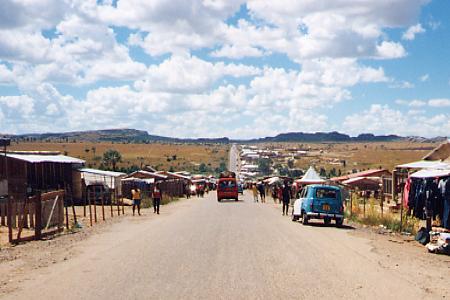|
Much of Madagascar's flora and fauna is unique to the island. There are 3000 endemic species of butterfly; the many
endemic species of lemurs fill the niches occupied elsewhere by animals as varied as racoons, monkeys, marmots, bushbabies,
sloths and even (though this variant is now extinct) bears; there is a similar diversity of reptiles, amphibians and
birds (especially ducks), and also at all levels of plant life. Wine is produced on Fianarantsoa Island. Unemployment
is a serious problem in Madagascar, consequently, travellers have to be alert to avoid theft and ensure their personal
safety like anywhere else in the world where desperate poverty is encountered.
Antananarivo:
|
The capital, Antananarivo, is high up in the Hauts Plateaux near the island's centre.
The broad avenue "Araben my Fahaleovantena" connects the Zoma Market with the railway station. The Zoma Market is a major
attraction every day but more particularly on fridays.
The Place de l'Indépendence is the heart of Tana, banks and fancy shops are here. There are even two cybercafés in
Ratsimilaho Street. Moving to the south of the city center is Anosy Lake with the monument to the dead heroes of
World War-I, erected by the French when Madagascar was still a colony.
|
|

Madagascar
©2001: Bernard Cloutier
|

Madagascar
©2001: Bernard Cloutier
|
|
Tourism:
Culture:
"He hira gasy" is a unique spectacle of music, dancing and story telling, performed by a number of wildly clad
troupes of about 25 performers. The performances begin with a complicated and eloquent kabary (discourse by an
orator); the message within the kabary is then performed by the troupe in wonderfully exuberant song and acrobatic
dances accompanied by tinny trumpet and clarinet music. The themes are always upbeat, extolling, and encouraging
young people to respect their parents. At the end a large hira gasy, the extent of the audience’s response to the
performances determines which troupe has won.
NOSY BE is the largest of the islands off the north-west tip of Madagascar (itself torn away from mainland Africa a
mere 160 million miles ago), Nosy Be presents an appealing and utterly relaxed holiday mood, thanks to the lure of
palm-fringed beaches and splendid coral reefs. Ylang-ylang, lemon-grass, patchouli, vanilla, cinnamon and coffee are
among the aromas in the air of this 'Ile Parfumee' as you wander among the friendly market and little shops of the
'capital', the unjustly-named Hell-ville! Beyond are the crater lakes and the panoramic views from the foot of Mt.
Passot, while a boat trip to Nosy Komba island brings you to the Black Lemur Sanctuary, habitat of one of 30 species
of the charming lemur, unique to Madagascar.
Economy:
The economy of Madagascar is dominated by agriculture, which employs three-fourths of the population. Agriculture,
livestock and forestry contribute 32 percent of GDP, industry 13 percent (with food industry, energy, and beverages
industry as main sub-sectors), and services about 55 percent. Over the last three decades, growth rates have averaged
only 0.4 percent each year. With population growth rates of about 3 percent, per capita incomes have declined sharply.
Since the late 1980s, the country has adopted more pragmatic economic policies: price distortions have been removed;
the exchange rate has been floated; energy prices have been increased; and commodity subsidies have been eliminated.

Lfandana
©2001: Bernard Cloutier
|

Llakaka
©2001: Bernard Cloutier
|
|
|
In recent years, the financial sector has been strengthened through bank restructuring and privatization. Key sectors
such as air transport and telecommunications have been exposed to increased competition. The economy has responded
positively to these reforms. During the period 1997-99, GDP grew at an average rate of 4.1 percent, and inflation has
been in single digits three years in a row. Some areas, such as agriculture, have not shown as much progress, however.
Sakaraha, also known as Sapphire town, has been the gem trading center of the country for many years but its predominance
is now being challenged by Llakaka further north since the discovery of precious stones in that area. Llakaka the new
sapphire city is only a shanty town for the time being. It is the lawless equivalent of America's Wild West of two
centuries ago.
|
History:
The first humans to settle here came from Africa like all of our species, but instead of crossing the 500 km strait
directly, they waited more than a hundred thousand years before coming very indirectly via Malaysia less than 2000
years ago. Arabs visited the island during the first millenium but did not stay. Beginning around 1500, a number of
attempts to settle the island were made by the Portuguese, the Dutch and the British but the most successful seem to
have been pirates of diverse origins who took local wives. Trade with the Europeans led to the development of local
kingdoms over which the Merina tribes of the central highlands gained hegemony in the late 18th century thanks to
European weaponry provided by competing British and French agents. Eventually, after much intrigue and infighting
between Protestant British and Catholic French missionaries, France became recognised as the colonising power in
Madagascar in an agreement that recognised British sovereignty over Zanzibar in 1890.
Madagascar was a French colony from 1896 until independence in 1960. Beginning in the 1970s, a military government
held power; however, the political system was opened up in 1990 after several political and economic crises. Opposition
political parties were legalized in 1990 and Madagascar is now a multiparty republic. The majority of the people on the
island are Malagasy, with cultural and historical ties both to Africa and Asia.
Enabling us to improve the quality of the content, if you have additonal information, remarks or suggestions, please
share it with us by e-mail.
ANTANANARIVO, July 12 2001: According to the National Institute of Science and Nuclear Technology, a study
revealed that at present, Magagascar's capital Antananarivo is the world's second most polluted city. Brazil's Rio
de Janiero comes number one.
Last update: April 20, 2008
|